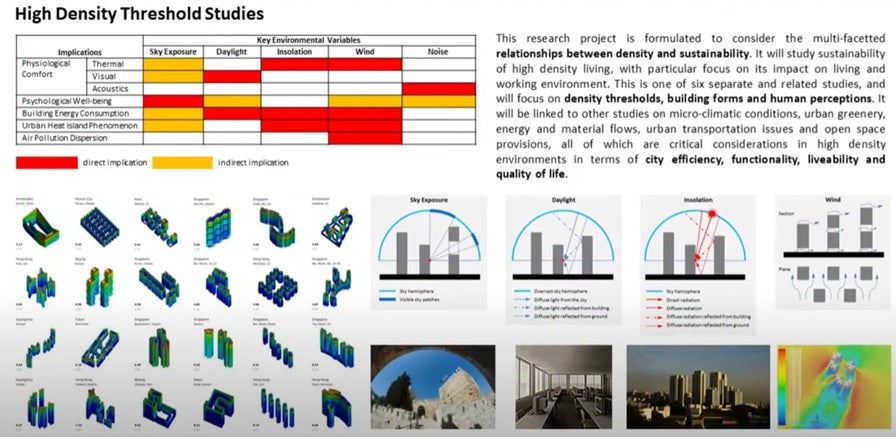High Density Threshold Studies
Principal Investigators:
Prof. Heng Chye Kiang; Dr. Malone-Lee Lai Choo
Executive summary
Compact high density developments are often regarded as an appropriate response to the objectives of sustainable development, particularly when seen against the concerns of urban sprawl, wasteful use of land and natural resources, and sub-optimal use of urban infrastructure. Following Agenda 21, the Green Paper on the Urban Environment presented to the European Commission in Brussels advocated that cities should be developed as dense urban cores which promote urban regeneration, reuse (optimal use) of infrastructure, containment of urban development, greater choice and diversity of work, live and play opportunities, mixed-uses, urban vitality and public transport use.
However, dense cities also bring about a host of other problems, e.g. urban pollution, traffic congestion, heat islands, social problems related to overcrowding, inadequate open spaces and amenities, public health problems such as spread of infectious diseases and high accommodation costs.
Hence, the research project is formulated to consider the multi-facetted relationships between density and sustainability. It will study sustainability of high density living, with particular focus on its impact on living and working environment. This is one of six separate and related studies, and will focus on density thresholds, building forms and human perceptions. It will be linked to the other studies on micro-climatic conditions, urban greenery, energy and material flows, urban transportation issues and open space provisions, all of which are critical considerations in high density environments in terms of city efficiency, functionality, liveability and quality of life.
Singapore is already a very dense city. How can we further accommodate urban growth and development in this context without compromising the concerns of environmental, social, and economic sustainability? Many developing cities, particularly in Asia, are also very dense. How do we apply the planning approaches and strategies derived from less dense cities in developed countries to support sustainable development in these cities?
The research project will be in two parts:
1. Simulation Studies of High Density and Urban Forms
Drawing upon the outcomes from the research project “Benchmarks, Best Practices and Framework for Sustainable Urban Development and Cities, this will be a studio-based study that simulates a variety of urban forms related to high density scenarios. Computer modeling techniques will be used to demonstrate the kind of urban environment that may result from high density configurations, which may or may not involve high-rise solutions. The range of urban forms and massing configurations for simulation and testing, would be drawn initially from theoretical and case study models, and later from the derived micro-climatic, urban space and natural lighting parameters.
2. Human Perception of High Density Residential Localities
This study, which involves a perception survey, is premised on the understanding that the acceptability of high density living is a pre-requisite to their successful implementation. Some part of the testing is envisaged to be

interactive with the computer simulation process, and the types of perceptual responses envisaged will include sense of crowdedness, psychological well-being, and sense of comfort, and convenience and privacy.


